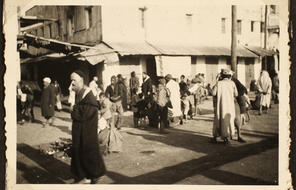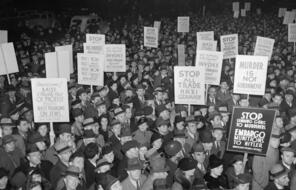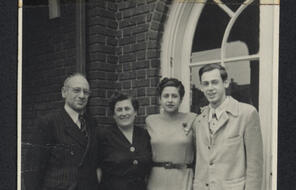Christian Churches and Antisemitism: New Teachings
Subject
- History
- Social Studies
Language
English — USUpdated
The death and devastation caused by World War II prompted nations to make the new commitments to justice and peace that were embodied in the Nuremberg trials, the Universal Declaration of Human Rights, the Genocide Convention, the International Criminal Court, and the United Nations itself. The war and the antisemitism that persisted afterward also made many people begin to rethink age-old religious teachings about the relationship between Christians and Jews.
By summer 1947, many feared that antisemitism in Poland and other parts of eastern and central Europe had reached a crisis level. Among them were 65 religious leaders and scholars from 19 nations—both Christians and Jews. At a meeting in Seelisberg, Switzerland, they expressed their concerns:
We have recently witnessed an outburst of antisemitism which has led to the persecution and extermination of millions of Jews. In spite of the catastrophe . . . antisemitism has lost none of its force, but threatens to extend to other regions, to poison the minds of Christians, and to involve humanity more and more in a grave guilt with disastrous consequences. 1
The gathering at Seelisberg was not the first interfaith conference. A few Jews and Christians had been meeting since the early 1900s. However, the Seelisberg conference was the first to examine the roots of antisemitism by using as its starting point a critique written by a Jew— Jules Isaac.
Before the war, Isaac had been France’s inspector general for education and the respected author of textbooks on French and world history. But when the Germans invaded France in 1940, he and his family were forced into hiding. Most of his family was discovered and shipped to Auschwitz. Only Isaac and his son survived the Holocaust.
During his years in hiding, Isaac tried to figure out why so many people in German-occupied Europe collaborated with the Nazis. He believed that one answer was the long history of the “teaching of contempt” for Jews and Judaism in Christian churches (see reading, Anti-Judaism before the Enlightenment in Chapter 2). With the help of several Christian scholars, Isaac studied hundreds of church documents while hiding from the Nazis. He traced early Christian hostility toward Jews to the years after the death of Jesus, when Jesus’s followers began to break away from their Jewish roots and to identify themselves as members of a separate, even superior, faith. Isaac explained:
Christian [teaching], once started in this direction, never stopped. Utterly convinced of its rights, it has repeated and [spread] these mythical arguments tirelessly, with methodical thoroughness, through all the powerful means that were—and still are—at its disposal . . . The result is that the myths . . . have eventually taken on the shape and consistency of facts, of facts that have become incontestable. They have ended up by being accepted as though they were authentic history. They have become an integral part of Christian thinking; nay, of the thinking of all educated people living in a traditionally Christian civilization. 2
Isaac’s analysis led some Christian leaders at the conference to reconsider their church’s traditional teachings about Jews. They created a document called the “Ten Points” that offered revised, more historically accurate teachings about the relationship between Christianity and Judaism. The first four points reminded Christians that their faith is deeply rooted in Judaism: “One God speaks to us all through the Old and the New Testaments.” They noted that “Jesus was born of a Jewish mother” and that the “first disciples, apostles and first martyrs were Jews.” And they emphasized that “the fundamental commandment of Christianity, to love God and one’s neighbor,” came from Hebrew scripture and “is binding upon both Christians and Jews in all human relationships, without any exception.” 3
The six remaining points made it clear that Jews and Judaism must no longer be presented negatively in Christian teaching. For example, the fifth point warned against praising Christianity by disparaging or mocking Judaism.
Christian churches continued to confront their legacy of antisemitism in the decades that followed. In 1965, Vatican II, a council of leaders of the Roman Catholic Church, approved a new official teaching document called Nostra Aetate (a Latin phrase that means “in our time”). Nostra Aetate condemned antisemitism and renounced the myth that Jews were responsible for the death of Jesus. It reaffirmed the Church’s belief in the validity of the Jewish faith and in an “eternal covenant” between the Jewish people and God. Changes in church doctrine were reinforced by changes in religious practice. For example, many Roman Catholics no longer said prayers referring to “perfidious [treacherous] Jews” during services on Good Friday.
These revised teachings, and others that have been revised more recently, have been influential, though many old myths persist. The work of Christian-Jewish dialogue continues.
Connection Questions
- Why did the events of World War II cause a reexamination of Christian teachings about Jews and Judaism?
- What conclusions did Jules Isaac reach about why so many people in German-occupied Europe collaborated with the Nazis?
- What were some of the ideas outlined in the “Ten Points” document and Nostra Aetate? Why might they be important for Christians who are trying to understand Judaism?
- What does it take to stamp out myths and misinformation that have persisted for centuries? What role do the teachings of religious leaders play? What else is necessary?
- What role might religion play in creating divisions in society? What might be the role of religion in healing divisions or building bridges?
- Where and how does antisemitism persist today? What must be done to combat it?
- 1“10 Points of Seelisburg: International Council of Christians and Jews (1947),” Boston College website, accessed July 13, 2021.
- 2Jules Isaac, The Teaching of Contempt: Christian Roots of Anti-Semitism (New York: Holt, Rinehart and Winston, 1964), 42.
- 3“10 Points of Seelisburg: International Council of Christians and Jews (1947),” Boston College website, accessed July 13, 2021.
How to Cite This Reading
Facing History & Ourselves, “Christian Churches and Antisemitism: New Teachings”, last updated August 2, 2016.













